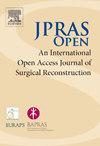Safety and efficacy of hairy scalp donors in thick split-thickness skin grafting: Healing and complications at donor sites
IF 1.5
Q3 SURGERY
引用次数: 0
Abstract
Background
We aimed to investigate how the thickness of removed skin grafts affects the healing time at the donor site, with a focus on the depth of the donor wound and the normal thickness of the scalp.
Methods
We examined the outcomes of the donor sites of thick split-thickness skin grafts using hairy scalp skin in 102 Korean patients. We measured the thickness of the scalp donor skin using preoperative ultrasonography, histometric thickness of normal scalp skin in 61 patients, and histometric thickness of the thickest part of the grafted skin after surgery.
Results
The mean normal ultrasound thickness of the scalp donors was 1.711 mm, with a mean histometric normal scalp thickness of 1.926 mm (61 cases), mean dermatome depth set of 0.569 mm (22/1000 inches, 22 mils), and mean histometric harvested skin thickness of 0.677 mm. The relationship between healing time and percentage of histometric graft thickness per ultrasonographic normal scalp skin thickness was statistically significant and correlated positively. Healing of the partial portion of the scalp was delayed in 9 donors due to infection and folliculitis. Scalp donor wounds healed during postoperative days 6 and 15, except for the ones with infected portions.
Conclusion
Patients in this study successfully achieved scarless regenerative healing of their scalp donor wounds. Furthermore, adequate wound dressing can prevent alopecia and scarring of infected donor wounds. The results of this study offer valuable insights into the advantages of using scalp skin in grafts, underscoring its potential as a preferred option for achieving optimal regenerative healing.
求助全文
约1分钟内获得全文
求助全文
来源期刊

JPRAS Open
Medicine-Surgery
CiteScore
1.60
自引率
0.00%
发文量
89
审稿时长
22 weeks
期刊介绍:
JPRAS Open is an international, open access journal dedicated to publishing case reports, short communications, and full-length articles. JPRAS Open will provide the most current source of information and references in plastic, reconstructive & aesthetic surgery. The Journal is based on the continued need to improve surgical care by providing highlights in general reconstructive surgery; cleft lip, palate and craniofacial surgery; head and neck surgery; skin cancer; breast surgery; hand surgery; lower limb trauma; burns; and aesthetic surgery. The Journal will provide authors with fast publication times.
 求助内容:
求助内容: 应助结果提醒方式:
应助结果提醒方式:


